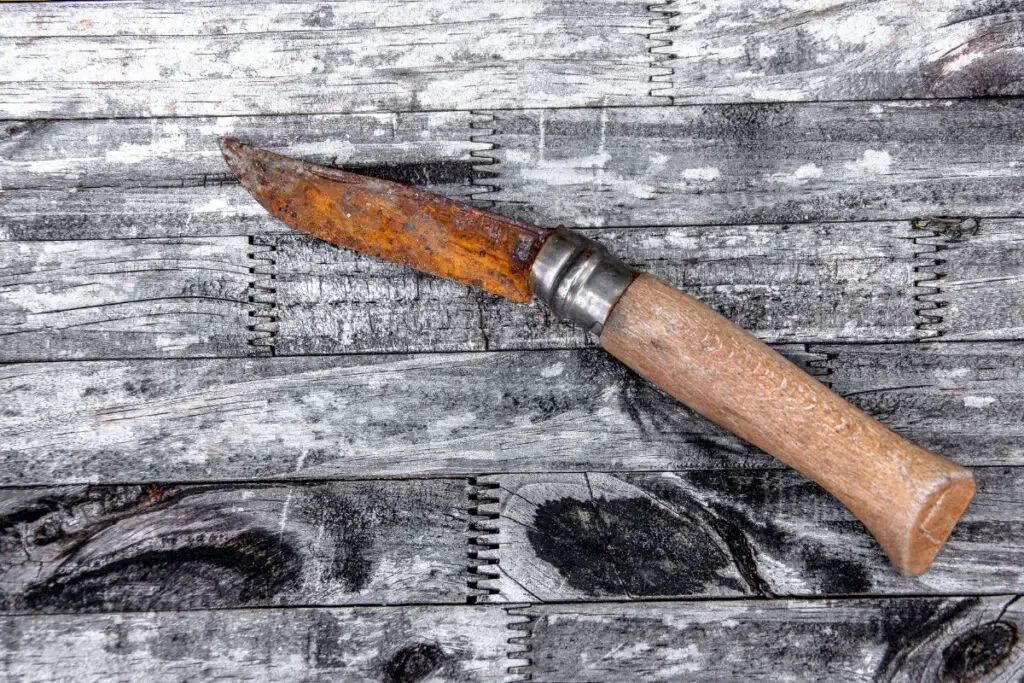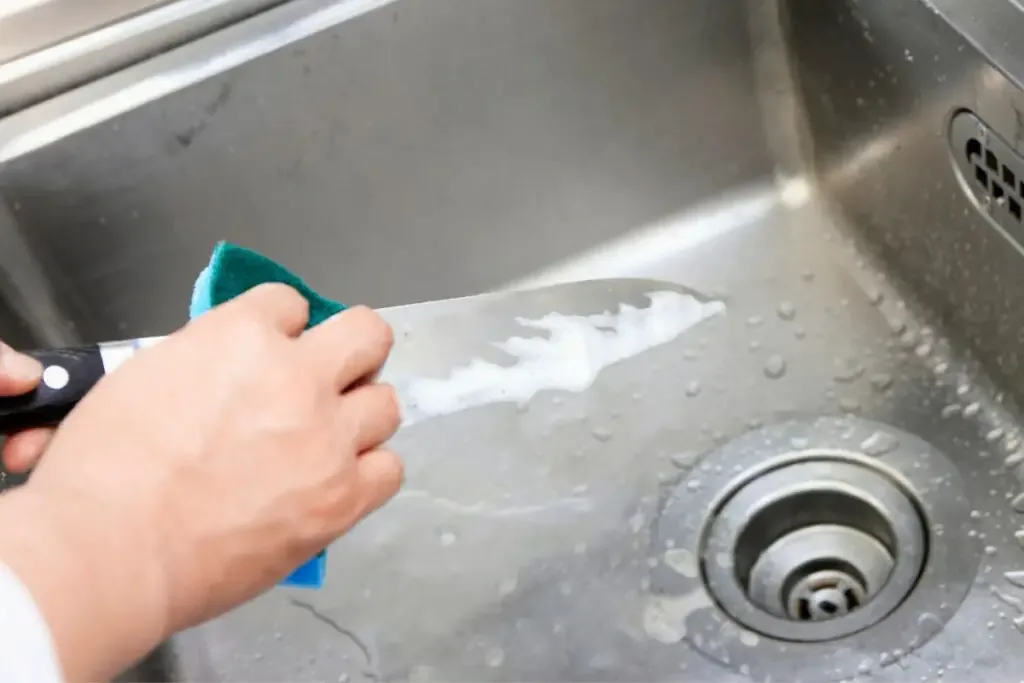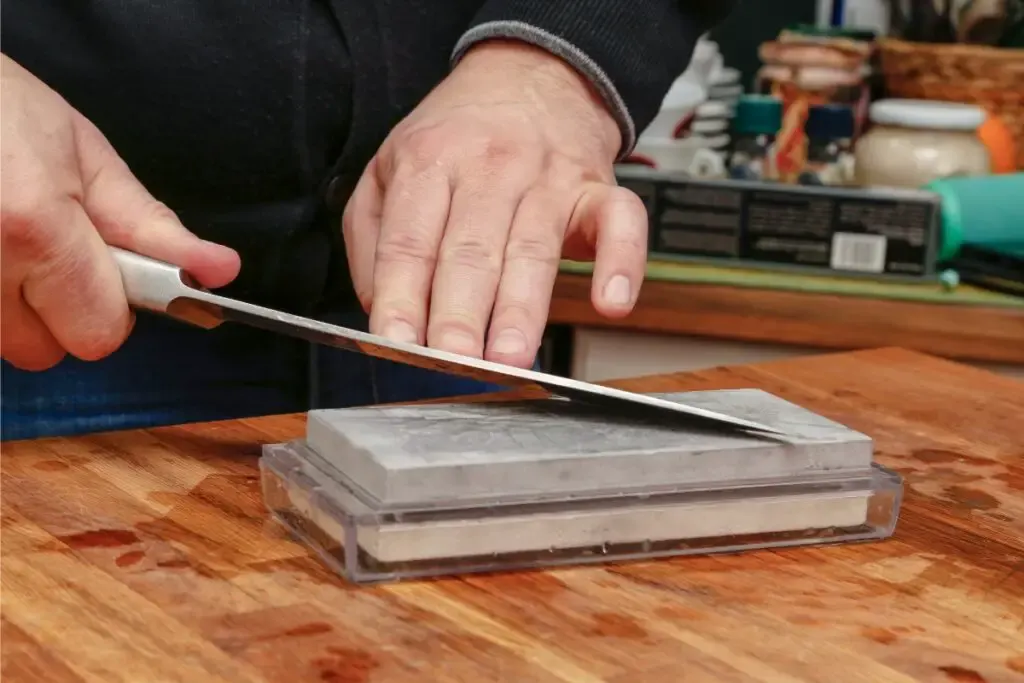As an Amazon Associate, we earn from qualifying purchases with no additional costs for you.
From dicing vegetables to carving meats, the sharpness and quality of a knife can significantly impact the outcome of a dish. But, like all tools, knives require proper care and maintenance to ensure their longevity, sharpness, and performance. One common kitchen habit, often overlooked, is leaving knives submerged in water, either in the sink or a dish rack. Does leaving knives in water dull them?
A knife left in the water can become dull. Corrosion from rust or mineral deposits from the water can contaminate the knife’s cutting edge, which will reduce the knife’s sharpness. Knives must be washed immediately after use and thoroughly dried before being stored to prevent this problem.
In this article, we’ll delve deep into the science behind knife maintenance, the effects of water on knife blades, and provide insights on how to keep your knives in tip-top shape.
If you are interested in checking out ta knife restoration kit we recommend and use, you can find it by clicking here (Amazon link).
Can A Knife Become Dull When Left In Water?

There are many situations that can result in a knife becoming dull, but one aspect that is seldom considered is whether leaving a knife in water can have this result.
Water is generally considered a fairly inert substance that does not do as much harm as acidic or alkaline solutions, but water can pose a threat to a knife in several ways.
The blade, the blade’s cutting edge, and the handle can all be damaged by significant exposure to water or even damp or moist conditions.
Factors That Dull Knives
A sharp knife is a joy to work with, slicing ingredients easily and precisely. However, even the best knives can lose their edge over time. Several factors contribute to the dulling of knives, and understanding these can help prolong the sharpness and efficiency of your blades.
- Natural Wear and Tear: Just like any tool, regular use of a knife will inevitably lead to some wear on its edge. Each time a knife makes contact with a cutting board or another surface, microscopic bits of the edge can be worn away.
- Cutting on Hard Surfaces: Surfaces like glass, granite, or ceramic are extremely hard and can quickly dull a knife’s edge. Opting for wooden or soft plastic cutting boards can help mitigate this.
- Exposure to Acidic Foods: Foods like tomatoes, citrus fruits, and pineapples contain acids that can react with the blade’s metal, leading to microscopic corrosion and dullness over time.
- Improper Cleaning: Using abrasive scrubbers or putting knives in the dishwasher can be detrimental. The aggressive environment inside a dishwasher, combined with harsh detergents, can damage the knife’s edge.
- Incorrect Sharpening Techniques: While sharpening restores a knife’s edge, doing it incorrectly can do more harm than good. Using the wrong angle or a subpar sharpening tool can damage the blade.
- Contact with Other Utensils: Storing knives in a drawer with other utensils can cause them to knock against each other, leading to chips and a dulled edge.
- Temperature Fluctuations: Extreme temperature changes from quickly moving a knife from hot water to cold can cause the metal to contract and expand, potentially affecting its sharpness.
- Improper Storage: Knives stored in humid or salty environments can develop rust or corrosion, which can dull the blade. Using a knife block, magnetic strip, or blade guards can help in proper storage.
Recognizing these factors and taking preventive measures can significantly extend the life of your knives, ensuring they remain sharp and efficient for a long time. After all, a well-maintained knife is not just a tool but a testament to a cook’s dedication to their craft.
While these factors can all cause a knife to dull, you will notice that water was not included in the list. Does this mean that water does not dull a knife? I believe leaving a knife in water should be on the list of factors that dull a knife. Let’s discuss what happens to a knife when exposed to water.
BTW: If you are interested in buying the best cutting board, you can find our recommendations below:
- The best overall: Virginia Kitchen Boys Cutting Board (Amazon link). This fantastic cutting board is made from sustainable walnut wood from the United States and brings almost perfect safety when cutting with your knives.
- Alternative: Yoshihiro Cutting Board (Amazon link). Professional traditional Japanese cutting board that chefs around the world use.
- Cheaper option: Shun Cultery Cutting Board (Amazon link). Another Japanese cutting board stands out, especially for its simplicity and affordable price.
TIP: Improper storage can also dull knives, but there are ways to store knives safely in a kitchen drawer. Find out how in our article below:
Storing Knives in a Drawer: 7 Ideas How to Do It Properly
The Science Behind Water And Knives

Water is a ubiquitous substance in the kitchen, and while it’s essential for many culinary tasks, it can have detrimental effects on knives if not understood correctly. Let’s explore the science behind how water interacts with knife blades and the potential consequences.
Corrosion And Rust Formation
Corrosion is a natural process where metal reacts with its environment and deteriorates over time. In the context of knives, this often means the formation of rust when the blade’s metal reacts with oxygen in the water.
Rust can pit and weaken the blade, making it more susceptible to chipping. Moreover, a rusted blade can contaminate food with iron oxide particles.
| Metal Type | Corrosion Resistance | Notes |
| Stainless Steel | High | Contains chromium, which forms a protective, rust-preventing oxide layer. |
| Carbon Steel | Low | More prone to rust but often preferred for its sharpness. |
| High Carbon Stainless Steel | Moderate | Combines the best of both worlds, offering sharpness and some rust resistance. |
Mineral Deposits
Tap water often contains dissolved minerals like calcium and magnesium. When water evaporates from a knife’s surface, these minerals can be left behind as mineral deposits.
Over time, these deposits can build up and create a rough surface on the blade, affecting its smoothness and sharpness.
| Mineral | Effect on Knife | Removal Method |
| Calcium | White spots or streaks on the blade | Vinegar or a descaling solution |
| Magnesium | Dull film on the blade | Acidic cleaners like lemon juice |
Thermal Expansion and Contraction
Metals, including knife blades, expand when heated and contract when cooled. If a knife is subjected to rapid temperature changes, such as moving from hot water to cold, it undergoes this process.
Repeated thermal cycling can introduce stresses in the metal, potentially leading to microscopic cracks or warping of the blade.
Understanding the science behind how water affects knives is crucial for any individual or professional who relies on these tools. By being aware of these interactions and taking preventive steps, you can ensure the longevity and efficiency of their knives, making every cut precise and effortless.
The Dangers Of A Dull Knife
While a gleaming, sharp knife might seem intimidating to some, it’s ironically the dull knives that pose a greater risk in the kitchen. The dangers associated with a dull knife are multifaceted, and understanding them is crucial for ensuring safety during culinary tasks.
- Increased Force Requirement: A dull knife requires more force to cut through ingredients compared to a sharp one. The extra pressure can cause the knife to slip, especially if it encounters resistance, leading to potential injuries.
- Inconsistent Cuts: A dull knife doesn’t slice cleanly through ingredients, leading to uneven and ragged cuts. Inconsistent cuts affect the presentation of a dish and its cooking time. Unevenly sized pieces may cook at different rates, leading to some parts being undercooked or overcooked.
- Strain on the Hand and Wrist: Using a dull knife can be physically taxing, requiring more effort and causing strain on the hand and wrist. Prolonged use of a dull knife can lead to discomfort or even repetitive strain injuries, especially in professional settings where chefs use knives for extended periods.
- Potential for Larger Injuries: If a dull knife slips, the force behind it can lead to more severe injuries than a sharp knife would cause in a controlled cut. A sharp knife might cause a clean, shallow cut if mishandled. In contrast, a dull knife can lead to jagged, deeper wounds due to the added pressure behind it.
- Food Safety Concerns: A dull knife can crush rather than slice, releasing more juices from ingredients, especially meats. These juices can spread bacteria, increasing the risk of cross-contamination in the kitchen.
While the gleam of a sharp knife might seem menacing, the dull blade poses the real threat. Ensuring that knives are regularly sharpened and properly maintained is a matter of culinary precision and a critical safety measure. A well-maintained knife elevates the cooking experience and ensures the kitchen remains a safe space for culinary creativity.
Proper Knife Cleaning And Maintenance

A knife requires regular care to maintain its functionality and longevity. Proper cleaning and maintenance ensure that your knife remains sharp and prevents potential health hazards. Here’s a guide to keeping your knives in pristine condition:
- Immediate Cleaning: Wash the knife immediately after use. Immediate cleaning prevents food residues from drying on the blade, which can be harder to remove later and can cause corrosion.
- Hand Washing vs. Dishwasher: Hand washing is always recommended for knives. Use warm soapy water with a soft kitchen sponge to gently clean the blade. Avoid abrasive scrubbers that can scratch the blade. A dishwasher is generally not recommended for knives. The aggressive environment, combined with harsh detergents and the potential for knocking against other utensils, can damage the knife’s edge and handle.
- Drying: Thoroughly dry the knife with a towel immediately after washing. This prevents water spots and mineral deposits and reduces the risk of rust formation.
- Regular Sharpening: Use a sharpening stone, honing rod, or a knife sharpener to maintain the knife’s edge. Regular sharpening ensures the knife remains efficient and safe to use. A sharp knife requires less force, reducing the risk of accidents.
- Storage Solutions:
A wooden or plastic knife block with slots for knives protects the blade from contact with other utensils. A magnetic strip mounted on a wall holds knives magnetically, keeping blades exposed but separated.
Blade guards are plastic or felt-lined covers that protect the blade, especially useful if storing knives in a drawer.
- Regular Inspection: Periodically check the knife for signs of wear, damage, or rust. Early detection allows for timely maintenance or replacement, ensuring the knife remains safe to use.
- Avoiding Extreme Temperatures: Don’t subject the knife to rapid temperature changes, like moving from hot water to cold. Extreme temperature fluctuations can cause the metal knife blade to warp or introduce stresses in the blade.
Proper cleaning, maintenance, and storage not only prolong the life of your knife but also enhance your knife-use experience. With the right practices, a quality knife can be a lifelong companion in the kitchen, assisting you in crafting countless delicious meals.
TIP: Ceramic knives require different sharpening tools and techniques than steel knives. Read all about sharpening ceramic knives in our article below:
Step-By-Step Guide: How To Sharpen A Ceramic Knife
Sharpening: Keeping Your Knives In Top Shape

Over time, even the best knives can lose their edge, making sharpening an essential aspect of knife maintenance.
While knives can become dull if left in water long enough for the edge to be compromised, sharpening can help restore the edge and keep the knife ready for use at all times.
If the damage to the edge is minor, a simple honing may be sufficient to remove corrosion or contaminants from the edge and restore sharpness.
However, if the knife has developed visible rust or mineral deposits, a thorough sharpening may be required to restore the edge.
The Importance of Sharpening: A dull knife requires more force to cut, increasing the risk of slipping and causing injury. Moreover, uneven cuts resulting from a blunt blade can lead to inconsistent cooking and presentation. Regular sharpening ensures that your knife performs at its best, providing clean, precise cuts with minimal effort.
Signs Your Knife Needs Sharpening:
- Difficulty in slicing through soft foods like tomatoes.
- The blade feels noticeably smoother when touched.
- Visible nicks or imperfections on the edge.
Different Sharpening Tools:
- Whetstones: Traditional sharpening stones that come in various grits. They require some skill and technique but offer precise sharpening.
- Honing Rods: Often mistaken for sharpeners, honing rods realign the blade’s edge without removing significant metal. They’re ideal for regular maintenance between sharpening sessions.
- Pull-Through Sharpeners: User-friendly devices where the knife is pulled through sharpening slots. They’re convenient but might not offer the precision of a whetstone.
- Electric Sharpeners: Automated devices that sharpen knives with minimal effort. They’re quick and efficient but can remove more metal than other methods.
| Tool | Pros | Cons |
| Whetstone | Precise sharpening can last a lifetime | Requires skill and practice |
| Honing Rod | Maintains edge alignment; Quick to use | Doesn’t sharpen a truly dull blade |
| Pull-Through | Convenient; Portable | Might not be suitable for all knife types |
| Electric Sharpener | Fast; Requires minimal effort | Can be aggressive; Might not offer precision sharpening |
Sharpening Technique:
- Angle: Maintaining the right angle is crucial. Most Western knives are sharpened at a 20-degree angle, while Japanese knives often use a 15-degree angle.
- Consistency: Ensure consistent pressure and maintain the same angle throughout the sharpening process.
- Direction: Depending on the tool and preference, you can sharpen by moving the blade away from you or in a back-and-forth motion.
Post-Sharpening Care: After sharpening, cleaning the knife to remove any metal filings is essential. A quick rinse and thorough drying will ensure that your freshly sharpened knife is ready for action.
Sharpening is an art and science combined. Whether you’re a seasoned chef or a home cook, understanding the nuances of knife sharpening can elevate your cooking experience, ensuring every slice, dice, and chop is a testament to your skill and dedication.
PRO TIP: We personally use diamond plates by Atoma. They are quite expensive but of the top quality with very long service life.
The initial costs are higher but you have an option of buying replacing diamond skin for all Atoma plates. The costs of replacing diamond skin are much lower than the cost of buying a new diamond plate.
So if you are going to use diamond plates regularly and want to get the best quality on the market, check out the four Atoma diamond plates listed below (Amazon links).
- Atoma Diamond Sharpener Coarse Grade 140 Grit
- Atoma Diamond Sharpener Medium 400 Grit
- Atoma Diamond Sharpener Fine 600 Grit
- Atoma Diamond Sharpener Super Fine 1200 Grit
These 4 diamond sharpening stones are all you need to have for repairing or sharpening your knives.
Conclusion
Knives are an indispensable tool in professional or home kitchens and play a pivotal role in transforming raw ingredients into delectable dishes.
For a knife to perform at its best, it must be well-maintained and receive the proper care to keep it in good shape for its intended purpose. Water can seriously compromise the knife’s cutting edge if it is left exposed to water or moisture for too long.
The recurring theme is clear: a well-maintained knife is not just about longevity but also about ensuring sharpness, safety, efficiency, and excellence in performance.
Learning to care for your knives correctly, including washing and drying your knives immediately after using them, will go a long way to preserving the sharpness of the edge and extending the overall longevity of the knife.
TIP: If Your knife loses sharpness fast, there could be a problem with usage, quality, or maintenance. Find out the top 5 reasons knives lose sharpness in our article on the topic!
Why Do Knives Lose Sharpness (So Fast)? 5 Common Reasons
